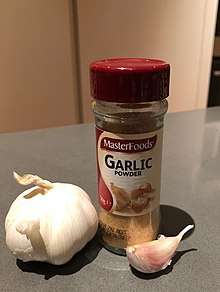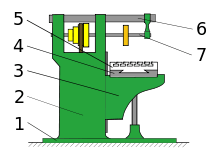Garlic powder
Garlic powder (pronounced /’gär-lik’/ and /ˈpau̇-dər’/)[2][3] is a seasoning that is derived from dehydrated garlic and used in cooking for flavour enhancement. The process of making garlic powder comprises drying and dehydrating the vegetable, prior to powdering it through machinery or home-based appliances contingent on the scale of production. Garlic powder is a common component of spice mix. It is also a common component of seasoned salt.
 Garlic powder and fresh garlic | |||||||
| Type | Powder | ||||||
|---|---|---|---|---|---|---|---|
| Course | Garnish | ||||||
| Place of origin | Central Asia | ||||||
| Region or state | Shandong, Henan, Jiangsu, Yunnan and Hebei | ||||||
| Associated national cuisine | Asian, Iranian | ||||||
| Cooking time | |||||||
| Serving temperature | Garnish or flavouring | ||||||
| Main ingredients | Garlic | ||||||
| Ingredients generally used | Sodium | ||||||
| 331 kcal (1386 kJ)[1] | |||||||
| |||||||
| Similar dishes | Garlic salt, Garlic flakes | ||||||
Production
Cultivation
There are two types of garlic species: Softneck (Allium Sativum Sativum) and Hardneck (Allium Sativum Ophioscorodon).[4] Hardneck garlic varieties are believed to have more flavour than Softneck garlics, characterized by a spicy and more complex taste than other garlic strands.[5] While Hardneck Garlics flourish in cold weather, due to their extensive time of vernalization, Softneck's seemingly grow better in warmer climates. Distinguishing between a Hardneck and Softneck garlic is done through the presence of a scape (flower stalk).[6] The garlic species most commonly used to powder is the Softneck variety. Due to their less-complex scent and taste, the Softneck species are more suited as a garnish or spice in dishes and also have a longer storage life than Hardneck varieties.[7]
Garlic cloves thrive when planted in mid-autumn, in a location with plentiful sunlight. In tropical areas, garlic most successfully grows when planted in Autumn, maturing in early summer and is planted in later Autumn in cooler areas, to be harvested in late Summer.[8] The larger bulbs are split and inserted into soil, around 4-6 inches apart, and 3 inches deep, with the pointy end facing upwards. Softneck and Hardneck garlic are planted identically, however, Softneck garlics are more suited to warmer climates.
Garlic must be harvested at a particular time in order to prevent the vegetable from rotting, while also maximising the growth of each bulb within the skin.[6] Green garlic is indicative of harvesting that has taken place before the cloves have developed, ‘soft’ garlic is the term given to a harvested garlic that is fully developed, while damaged garlic, with a caramelised appearance inside, has been harvested too late and a result of frost.[6] When the leaves turn yellow in colour, harvesting may be initiated.[8]
Manufacturing

Garlic cloves are peeled and sliced. In most cases, the garlic is then heated to a temperature of between 150° and 160 °C (~300-320 °F). The water is removed to a moisture content of about 6.5%. The dehydrated garlic is then further sliced, chopped, or minced until the powder is reduced to the desired particle size.[9] Manufacturing garlic powder on a larger scale involves various steps, from extraction of the garlic bulbs to packaging the final powder. After harvesting the raw garlic, bulbs are cleaned under mild pressure to remove skin and separate the cloves.[10] The garlic is then dehydrated using both historical and newly developed methods. While old methods, such as using natural elements of sun and wind to evaporate water from foodstuffs are still utilized in many parts of the world,[11] new technology has enabled for more flexible and economically viable procedures such as vacuum and freeze drying. Once the garlic cloves are dried and dehydrated, they are powdered using large scale machines and powdering units.[12]

Milling is the process of using mechanical action to break down substances through rotary cutting.[13] As powder processing generally includes additives and is done in a bulk scale, the milling process breaks down materials to the required size for suppliers.[14] Milling may require a series of steps, from de-agglomeration to fine grinding. The four components include Delumpers, Conical mills, Hammermills and Fine grinders. The garlic powder industry utilises milling machinery in order to progress with large scale production. The integrated systems of the machine consist of Feeding and metering, Sifting, Conveying and Dust collection.[14] Another major machine used in the process of creating garlic powder is a vacuum dehydrator, which takes all the moisture from the vegetable without spoiling colour, scent and taste.[15] Freeze drying is also used in the garlic industry as an alternative to vacuum dryers.
In India, on a scale of 300 tonnes of garlic powder production per year, the manpower required to operate the machinery and overlook the production units is 12 persons. The estimate for this scale of production is around two skilled workers, two semi skilled workers and eight helpers.[10]
Regions
There are approximately 300 types of garlic produced worldwide.[16] The most prominent Garlic market segment regions include North America, Europe and Asia-Pacific. Within China, which produces the most significant amounts of garlic across the globe, there are five main provinces in which garlic is harvested. These five provinces are Shandong, Henan, Jiangsu, Yunnan and Hebei.[17] As soft neck varieties tend to flourish in warmer climates where winters are mild, the Chinese provinces are suitable for harvesting and manufacturing garlic powder.
Market
The market for garlic powder can be split into multiple segments based on source, packaging, end use and distribution channels. The key market players in the Garlic Powder industry are inclusive of some of the world's most renowned manufacturers and suppliers such as McCormick and company inc, Garlico industries limited, Masterfoods ltd and Amazon spices private limited.[18]
China is the largest producer of garlic powder, followed by India, with both countries consuming garlic powder as part of their native cuisines and having hundreds of their own internal suppliers within the countries.[19]
Usage

History
While doubts still remain about Garlic's exact origins, it is believed to have originated in Central Asia, South Asia, or southwestern Siberia.[20] Garlic grows wildly in Italy and Southern France, but is predominately grown in China, which accounts for 20.0 million tonnes of Garlic per year (80% of total production).[21] Garlic has been a substance used for thousands of years and has served many purposes, from medicinal uses to culinary and spiritual practices. The nutritional properties of garlic have created many benefits for human use and offer a wide range of purposes.
Culinary use
The use of garlic as a food has ancient origins in Asia. Garlic has been used for centuries as a wholefood, and as a flavouring agent.[22] Garlic can be manipulated in multiple ways to create bi-products, such as powder, oil and salt, to enhance foods in both nutrients and flavour. Garlic powder is a common additive to traditional dishes of central Asia and European countries as it provides the flavour of garlic without the labour of preparing the fresh vegetable and sustains a longer storage life.
Storage
Dependent on the storage conditions, garlic powder generally lasts in good condition up to 4 years. Manufactured garlic powders have a ‘best before’ date printed on them to provide an estimate for how long the powder will be in peak condition for in respect to flavour and texture.[1] Garlic powder must be stored in a cool, dry place, to avoid clumping of the powder. If powder is exposed to moisture or heat, it could cause the product to harden or clump.[23] Fresh garlic remains ripe for up to half a year as a whole bulb, and up to a month if it is an unpeeled clove, while dehydrated garlic can last for years.[11]
Medicinal use
Garlic is known for its medicinal properties and has traditionally been used to heal, strengthen and treat humans for centuries. The origins of Garlic in Ancient Egypt suggests that it was used regularly as part of many Egyptians diets’, particularly the working class who worked on the pyramids and had other laborious tasks.[22] As garlic was left in King Tutankhamen's tomb (1500 BC), it is also believed to have biblical significance, healing, and preservation powers to ancient Egyptians. Other places of origin such as Ancient Greece, Ancient China and Japan, Ancient Rome and Ancient India utilised garlic for its medicinal properties and perceived healing powers such as treatment of leprosy and parasitic infestation too.[24] While garlic is used still today to treat cardiovascular diseases, diabetes, hepatoxicity and viral problems, garlic powder is not as predominately used due to its lessened nutritional value through the dehydration process. Garlic powder is included in diets to lower systolic blood pressure, but has not been proven to lower the risk of cardiovascular morbidity in people with hypertension as garlic alone has been successful in doing.
Nutritional properties
| Nutritional value per 100 g (3.5 oz) | |
|---|---|
| Energy | 1,390 kJ (330 kcal) |
72.7g | |
0.73g | |
16.6g | |
| |
| †Percentages are roughly approximated using US recommendations for adults. | |
While garlic naturally comprises carbohydrates (85%), protein (12%), fats (3%)[1] and is high in vitamins and minerals, the powdering process reduces the nutrition levels significantly, narrowing its purpose predominantly to flavour addition. Garlic powder has, however, been included in diets to lower blood pressure and assist with diabetics given its abundance of B-6, phosphorus, and manganese[25]
See also
References
- "Spices, garlic powder". FoodData Central. U.S. Department of Agriculture. 2019-04-01. Retrieved 2020-05-30.
- "Garlic". Merriam-Webster. Retrieved 2020-05-29.
- "Powder". Merriam-Webster. Retrieved 2020-05-29.
- Perry, Leonard (2017-03-30). "Types of Garlic". Perry's Perennial Pages. Retrieved 2020-05-29.
- Vanderlinden, Colleen (2019-10-01). "Grow the Right Garlic for Your Needs". The Spruce. Retrieved 2020-05-29.
- OECD (2017-07-27). International Standards for Fruit and Vegetables (Report). Paris: OECD Publishing. doi:10.1787/9789264272941-en-fr. Retrieved 2020-05-29.
- Congdon, Vicky. "A Passion For Garlic". The National Gardening Association Learning Library. Retrieved 2020-05-29.
- Stephenson, Kay (2012). "Growing your own Garlic". Warm Earth (100): 46–47.
- Luh, BS; Woodruff, JG (1975). Commercial Vegetable Processing. Westport, CT: AVI. pp. 401–403. ISBN 978-0-87055-282-3.
- "Garlic Powder". Technology Innovation Management & Entrepreneurship Information Service. FICCI. June 2010. Retrieved 2020-05-29.
- Greensmith, Maurice (1998). Practical Dehydration. Woodhead Publishing Series in Food Science, Technology and Nutrition (2nd ed.). Elsevier. ISBN 185573656X.
- Attokaran, Mathew (2017-01-07). "Chapter 6. Preparation of Plant Material for Extraction". Natural Food Flavors and Colorants (2nd ed.). John Wiley & Sons Ltd. doi:10.1002/9781119114796.ch6. Retrieved 2020-05-29.
- "Process of CNC Milling". Ardel Engineering. Retrieved 2020-05-29.
- "Grinding and Milling". Powder Process-Solutions. Retrieved 2020-05-29.
- Chen, Yannan; Li, Meng; Dharmasiri, Thasmi Shashikala Kumari; Song, Xiangyun; Liu, Feng; Wang, Xiao (2020-02-15). "Novel ultrasonic-assisted vacuum drying technique for dehydrating garlic slices and predicting the quality properties by low field nuclear magnetic resonance". Food Chemistry. 306: 125625. doi:10.1016/j.foodchem.2019.125625. ISSN 0308-8146.
- De La Cruz Medina, J; García, HS (2007-12-21). Mejía, Danilo (ed.). Garlic: Post-harvest Operations (PDF) (Report). INPhO Post-harvest Compendium. Food and Agriculture Organization of the United Nations.
- Blazyte, Agne (2019-09-23). "Production volume of garlic in China as of 2016, by leading province". Statista. Retrieved 2020-05-29.
- Zion Market Research (2018-12-05). "Global Garlic Extract Market Will Reach USD 15.30 Billion By 2024". GlobeNewswire. Retrieved 2020-05-29.
- "Garlic Powder Manufacturers and Suppliers". ExportersIndia.com. Retrieved 2020-05-29.
- "Garlic and History". Grey Duck Garlic. Retrieved 2020-05-29.
- Chepkemoi, Joyce (2017-04-25). "The Top Garlic Producing Countries In The World". WorldAtlas. Retrieved 2020-05-29.
- Rivlin, Richard S. (2001-04-01). "Historical Perspective on the Use of Garlic". The Journal of Nutrition. 131 (3): 951S–954S. doi:10.1093/jn/131.3.951S. ISSN 0022-3166.
- Wahlig, Hannah. "How to Keep Garlic Powder From Caking When Stored". LEAFtv. Retrieved 2020-05-29.
- Bayan, Leyla; Koulivand, Peir Hossain; Gorji, Ali (2014). "Garlic: a review of potential therapeutic effects". Avicenna Journal of Phytomedicine. 4 (1): 1–14. ISSN 2228-7930. PMC 4103721. PMID 25050296.
- Kusuma, Pramudita Putri (2016-03-01). "Effect of Garlic Powder Addition to Gelatin Biocomposite on its Antibacterial Activity". Alchemy Jurnal Penelitian Kimia. 12 (1). doi:10.20961/alchemy.v12i1.786. ISSN 2443-4183.